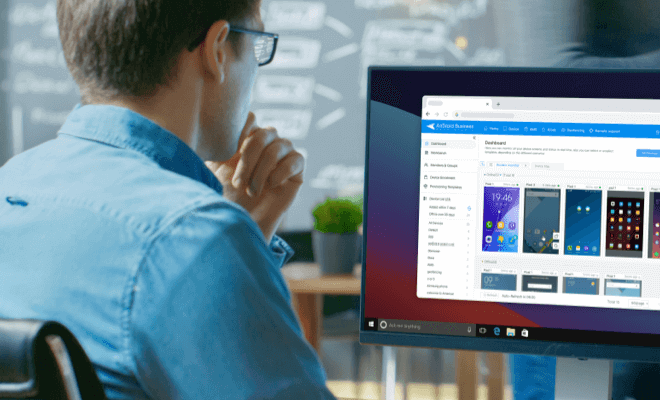- Integrated with Google Android Enterprise
- Remotely manage, monitor, and troubleshoot devices.
- Lockdown devices into kiosk mode
- Implement security policies and device limitations
What is Android Enterprise & What Does It Mean for MDM?
With over 2.5 billion users, Android enjoys a dominant 85% market share in the mobile operating space. It does have one glaring weakness however: enterprise. Most businesses still favor iOS, the operating system of Apple devices like the iPhone and iPad.
What is Android Enterprise?
As part of Google’s bid to secure more of the enterprise market, Android Enterprise is a software platform that provides application programming interfaces (APIs) to developers who build MDM solutions. The goal was to make it easier for them to develop these applications, give them more flexibility in how they do so, and increase the security of their MDM and devices.
Since its release, Android Enterprise has undergone notable changes that advance this mission. Enterprises should be aware of these new features, so that they can choose the MDM that maximizes their potential. Android Enterprise ultimately means little, after all, if the MDM provider is not tapping into its full feature suite.
1 Android Enterprise Main Features
Android Enterprise provides organizations with a combination of features that allow managing Android-based devices on an enterprise level. The following are the features that are provided:

Data Separation
The profile of work on Android allows for securing and isolating the work applications from the personal applications. This works on both company-owned and employees' devices. Such separation allows to keep both the company and employees' data safe and secure.
Security
The devices that leverage the Android Enterprise solution can also benefit from Google Play Protect. Google Play Protect has several features that keep any of the devices free from malware, viruses, and threats.
Apart from that, the companies can also use other security features such as password policies, screen locks, and encryption for a better and further layer of protection.
App Management
Streamlined App Distribution: The Android Enterprise also contains a feature that allows the IT admins to control how the applications are listed on Google Play. Organizations can even create a customized Google Play for their employees for a better experience so they can find and install the applications easily.
Private App Support: In the Android Enterprise solution, the IT admins (Management) can easily distribute private applications alongside public apps. This means that businesses can distribute apps that are not available in the public Google Play Store, such as custom line-of-business apps. These apps could be of the business itself or the ones only made for employees for a specific purpose or work.
More Than 80 Management Settings
In Android Enterprise, there is a huge range of management settings that can be used to customize the employee experience. These settings include things like device restrictions, app permissions, and security policies.
2 What Android Enterprise Means for MDM?
Android Enterprise caters to the changing nature of work
While the pandemic may be over, its impact remains. Some companies have gone fully remote. Others have gone hybrid, reporting to the office a few days of the week. Still others are once again fully on-site, with new protections for a post-pandemic world.
Because how people work has changed, what kind of devices they use has also changed. There are now a diversity of device policies. For example, some organizations are saving on hardware by encouraging employees to BYOD, or “bring your own device.” Other organizations still embrace top-down ownership, but this has fractured into different models, including corporate-owned, personally enabled (COPE); corporate-owned, business only (COBO); and corporate-owned, single use (COSU).

Android Enterprise succeeds because it caters to any of these models. With BYOD and COPE, for example, the line between professional and personal life can be challenging to manage. An IT team should be able to monitor and access a device, but this may cause them to inadvertently stumble upon private information, such as a person’s browsing habits, personal communication, or app usage.
An MDM powered by Android Enterprise now addresses this challenge with separate profiles. An employee will have a work profile, which IT teams will be able to configure, manage, and access. More crucially, the employee will also have a personal profile, where they will have complete privacy. This ability to compartmentalize one’s digital work life from their personal life makes BYOD and COPE policies much easier. Now enterprises can manage the delicate balance between securing these devices without infringing on employee privacy.
Android Enterprise has similar allowances for other device policies, which makes it ideal for modern organizations that rely on an MDM for their workforce: No matter which one the organization chooses, safety, security, and efficiency will be maintained.
Android Enterprise provides enterprise-level security
The major reason that enterprises prefer iOS over Android is security. There are generally more cybersecurity threats to Android for several reasons. The first is that iOS is a closed ecosystem, whereas Android is open source, making it easier to develop malware and viruses which target that operating system.
The second is Android’s sheer market dominance: From a cost-benefit perspective, it makes more sense for hackers to target them versus iOS.
These threats are substantial to enterprises for several reasons.
Mobile devices can be used as an entry point for hackers to gain access into other technology systems of the organization.
Because employees use mobile devices for work, hackers may use them to access sensitive information, such as the organization’s banking details.
Successful attacks on mobile devices may lead to data or financial losses, inflict reputational damage of the brand, and disrupt business operations.
To win over more of the enterprise market, Android must understandably tighten its security. Android Enterprise is also meant to heighten its cybersecurity protocols through a variety of changes.
One is Android Enterprise Recommended, which is a vetted list of device providers that meet a high level of security standards, including quarterly security updates, the minimum device specifications for enterprise use, and support of the current and next operating system as well as the latest MDM features. Because device security begins with hardware, Android Enterprise Recommended makes it easier for enterprises to choose a strong foundation for their device ecosystem, which they can further strengthen with an MDM.
Another important security feature is zero-touch enrollment, which is exactly what it sounds like: IT teams can configure a phone without having it in hand. This makes it ideal for large rollouts and also as a fail-safe. If a device is stolen, the thief will most commonly try to reset it. With zero-touch enrollment, even this will not remove the MDM, which buys the organization time to locate the device via geo-location. They can also elect to remotely lock the device and wipe it clean of any company data.
Finally, the company can set policies around security, such as lock screen restrictions. If a company feels that a numeric passcode is not secure enough, they can require a longer password. Similarly, companies can prohibit employees from accessing apps that do not comply with the organization’s security policy. This automatic compliance enforcement acts as tight guardrails, keeping employees within safe, designated workspaces.
Working with the right MDM will enable organizations to execute these policies, and in some cases even exert even more granular control.
Android Enterprise facilitates content distribution
The point of having a device dedicated in whole or in part to work is content. A sales person will need access to a mobile CRM, a finance person will need access to accounting software, a HR person will need access to the HRIS, and all employees will need access to messaging platforms, collaboration tools, and other productivity software.
It is an operational nightmare when these apps are not delivered in a standardized fashion.
For example, if a company onboards a new timekeeping provider and asks employees to download their app, compliance will be low. Some will download right away, while others will put the task off for as long as they can. This lack of compliance increases switch-over costs for each company: Now the company must spend valuable time corralling employees into downloading the required app.

The same goes for any updates. Even if a device was deployed with a necessary app, employees cannot be counted on to regularly update it. In fact, they will likely put off this task until the last minute (all professionals can likely recall a virtual meeting that started late because various members had to update to the latest version of a given software). When businesses rely on employee-initiated updates, many operational issues are bound to occur.
Extended access to specific users for different apps has traditionally been just as cumbersome. Configuring these permissions takes much longer than it should be, and marks a notable departure from consumer-facing apps. On Facebook, for example, it only takes a few clicks to extend various administration roles for a page to different company representatives. The process for doing the same for work-related devices is notoriously difficult.
Android Enterprise makes app management significantly easier. Through an enterprise Google Play account, IT teams can enroll individual users, manage their accounts, and create app distribution rules at the per device level. They can also silently configure apps without any necessary work from the device owner, including installing, updating, or uninstalling apps. From Android Enterprise, they can also review app permissions and the entire app catalog.
An MDM integrated with Android Enterprise will allow enterprises to operate with far greater efficiency as it relates to their device ecosystem. Rather than have these endpoints represent a logistical nightmare, they can further the aims of the organization, providing employees with the right access to the apps they need to succeed.
Android Enterprise means business
When organizations begin the procurement process for their devices, they must begin with a tough choice: Should they go with iOS or Android? Up until recently, the answer for most organizations has been the former. With the evolution of Android Enterprise, however, Android should become an increasingly popular choice. The pairing of Android Enterprise with an exceptional MDM gives enterprises several key advantages.
The first is flexibility. Work has forever changed, and central to this is the merging of our professional and personal lives on our devices. Android Enterprise caters to this seismic change with the introduction of work profiles. Now organizations can have necessary access to devices, and employees can still enjoy their privacy. This setup is particularly apt for BOYD and COPE models.
The second is security. Cyberattacks have been more common on Android devices. This threat is a serious one for organizations, who can suffer significant financial losses, data theft, and reputational damage from even a minor hack. Android Enterprise beefs up security for enterprises through a suite of new features, such as zero-touch enrollment, lock-screen restrictions, and automatic compliance enforcement. Now security becomes a strongpoint for Android devices.
The final benefit is app management, which has traditionally been inconvenient. When organizations rely on employees to download or update the apps they need, work slows down. Android Enterprise gives businesses the top-down levers they need to manage work-related apps, so that employees can focus on what matters most: producing.
Given these advantages, organizations should choose an MDM that not only integrates with Android Enterprise, but maximizes its benefits.
3 Flexible Solution for Different Scenarios
There can be a number of use cases where the different scenarios and how Android Enterprise can be applied:
- BYOD (Bring Your Own Device): In this scenario, employees use their personal devices for work purposes. Android Enterprise allows IT admins to manage the company-owned work profile on the employee's device but there is still a part of unmanaged personal profile. This means that the IT department can control what apps are installed on the work profile, as well as the security policies that apply to those apps. The employee's personal data and apps are not affected by Android Enterprise.
- COPE (Company Owned, Personally Enabled): In this scenario, the company owns the device, but the employee is allowed to use it for personal purposes as well and that personal profile has partial or limited visibility. Android Enterprise allows IT departments to create a work profile on the device. This way, the company can still control the work profile and the apps that are installed on it, while the employee can use the rest of the device for personal use.
- COBO (Company Owned, Business Only): In this scenario, the company owns the device and it is only used for work purposes. Android Enterprise allows IT departments to manage the entire device, including the apps that are installed and the security policies that are applied.
- COSU (Company Owned, Single Use): In this scenario, the company owns the device and it is locked into a single-use mode or kiosk mode. This means that the device can only be used for one specific app or a small set of apps. Android Enterprise allows IT admins to manage the device fully and lock it down to kiosk mode.
4 Reasons for Android Enterprise being Introduced
Reason 1. Limitations of Device Admin
This is a legacy management mode that gives IT admins some control over devices. However, it’s less secure than the other options. It wasn't ideal for mixed personal and business use cases.
There were security limitations.
Reason 2. Need for a more robust solution
Businesses likely required a more secure way to manage devices with work data.
Work Profile: This is a feature of Android Enterprise that allows IT admins to create a separate, secure work profile on an employee's device. This means that personal data and work data are kept separate.
Fully Managed Device: This is a management option for Android Enterprise where IT admins have complete control over the device. This includes the ability to restrict apps, wipe data, and more.
5 What is Android Enterprise Recommended?
Android Enterprise Recommended is a program by Google that shortlists the top-tier devices and services that are specifically designed for the business world. These devices go beyond the standard or default Android offerings by meeting stricter requirements in terms of productivity, hardware, security, privacy, deployment options, and user experience.
This specific selection of the program simplifies the search for businesses seeking reliable and secure solutions and devices for management for their mobile workforce. Inclusion in the program signifies a device's commitment to delivering exceptional performance, longevity, and a user-friendly experience for enterprise use.
Conclusion
Android Enterprise authorizes businesses of all sizes and across industries to make use of the power of Android devices in a secure and manageable way. From data separation to powerful management of the applications, Android Enterprise provides the needed tools and features necessary to equip your workforce with the mobile tools they need to be productive while ensuring the security and control your business requires.
Whether you're managing employee-owned devices (BYOD), company-owned devices (COBO), or a mix (COPE), Android Enterprise offers a comprehensive solution to meet your specific needs. As Android continues to evolve, so too does Android Enterprise, constantly adapting to provide cutting-edge solutions for the ever-changing mobile landscape.

Mobile Device Management for Android Devices
AirDroid Business provides an all-in-one MDM and remote control solution that helps your IT teams remotely provision, monitor, control, and secure unattended or attended Android devices. This datasheet gives you an overview of the benefits, core features, and pricing plans to fast track your research.





Leave a Reply.